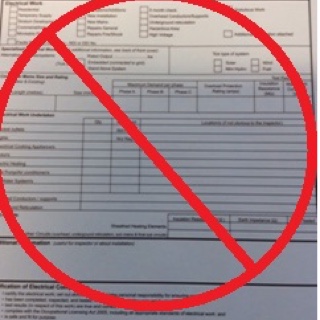Information
-
Client / Site
-
Conducted on
-
Prepared by
-
Location
-
Initial Date of Installation
-
BESS System Size
BESS Equipment
-
BESS Manufacturer and Model
-
Quantity of PCE's Installed
-
Battery Chemistry Type (ES)
-
Has a MSDS been made available to determine risk mitigation, essential to to the chemical hazards?
-
Describe the System Configuration ie 4 Batteries in series, 2 Strings in Parallel . and the Total BESS Ah
-
Quantity of Battery Modules Installed
BESS Installation
-
Describe the actual installation location of the BESS
-
Is the Installed location Compliant? Installed in a Battery Enclosure, Room or fenced-off area which is:<br>Mechanically sound <br>Suitable for the local environmental conditions <br>Designed to prevent the formation of ‘gas pockets’ <br>In a domestic dwelling not in a habitable room (as defined by the National Construction Code 2015) <br>Not in direct contact with the floor of the enclosure or room
-
Battery Systems and pre-assembled BESS shall not be installed in "Habitable Rooms"as defined by the National Construction Code (NCC),
-
Photo showing the BESS Installed Location
-
Provide information of any issues relating to the installed BESS location.
-
The storage system is installed in such a way that it is NOT exposed to direct sunlight at any time, or partially exposed (which would create temperature differentials across the batteries) <br>or it is rated by the manufacturer for the installed conditions
-
The system is installed in accordance with the environmental conditions it will be subjected to?
-
All battery terminations and interconnect cable connections have been checked for tightness
-
All electrical cables, isolators and fuses are correctly rated and sized for operating and fault <br>conditions
-
There are no exposed electrically ‘live’ parts on any installed equipment
-
All battery cell interconnects and terminals are covered and protected against accidental short circuit
-
All ‘live’ cables have been tested for electrical leakage to earth
-
Electrical wiring is routed so as to be protected from any physical damage or mechanical stress and exposure that could cause corrosion
-
Installation activities have not caused any damage to any cable insulation
-
All electrical wiring has been installed in accordance with AS/NZ 3000, and equipment is certified for use in Australia
-
Unearthed conductors in battery banks (including multiple strings) are protected by over current circuit breakers or fuses
-
Battery banks have a means of isolation. Such isolation has been checked and tested, and is as close as practicable to the Battery system.
-
Battery storage warning signs (i.e. ‘DANGER – Risk of battery explosion’ and ‘DANGER – Harmful voltage’) are permanently fixed outside the battery room, enclosure or area in a prominent position, and are appropriate for the battery chemistry type
-
All other appropriate signage is displayed; for example, shut down procedure, emergency contact details, emergency response procedures, maintenance and operation procedures, ‘Warning – Spark hazard’, ‘electrolyte burns’, battery voltage and short circuit fault current warning
-
Voltage, current and power throughput have been verified and are within the design specification for intended use and load profile
-
Metering is installed to monitor the battery voltage
-
Visual and audio alarms and warning notifications have been tested correctly
-
A tailored fire response, including, if necessary, a fire extinguisher has been installed adjacent to the batteries along with a sign detailing the actions to be taken in the event of a fire
-
All commissioning tests and results have been documented
-
Material Safety Data Sheet (MSDS) has been provided to the system owner
Led Acid Specific
-
All crimp lugs have been fitted using an appropriate tool
-
Batteries are installed on a timber or other suitable platform (to reduce short circuit risk and hazardous gas production if a battery were to leak acid)
-
The clearance and ventilation of equipment and arc-producing devices is in accordance with manufacturer’s installation guidelines or relevant standards, including AS4086.2 and AS4509.2
-
The enclosure is constructed of corrosive-resistant materials
-
Personal protective equipment and electrolyte containment is provided, including spill kit, eye protection, gloves and eye wash water
-
Provide photos of any issues identified.
-
Provide information regarding any issues identified.
Lithium-ion specific
-
Platform and enclosure is constructed of aluminium or steel (to minimise risk of fire)
-
Batteries are in a sealable enclosure with pressure activated venting, ducted to the open atmosphere away from living spaces or areas occupied by people and animals (see habitable rooms in ‘all batteries’, above)
-
Enclosure base is sealed from the atmosphere
-
Battery management system has been verified as operating correctly, including logging data
-
Provide photos of any issues identified.
-
Provide information regarding any issues identified.
Documentation
-
All documentation relevant to a system installation shall be provided to the customer<br>and kept on-site for use by maintenance personnel
-
A system user manual that includes a short description of the function and operation of <br>installed equipment
-
A list of supplied equipment
-
A list of any alarms installed and the action required
-
Equipment manufacturers’ documentation and handbooks for all equipment supplied
-
Manufacturer’s warranty information
-
A copy of the shutdown procedure and any electrical safety warnings
-
Battery maintenance record logbook, and schedule timetable (See Appendix E – Battery Maintenance Log Book)
-
Commissioning records and this checklist for the installation
-
Record of installation personnel details
-
System electrical wiring connection diagram
-
Any Additional Information regarding issues identified with the Documentation
MAIN SWITCHBOARD
-
Describe where the Main Switchboard is Located
-
Is the switchboard arrangement compliant?
-
Record the rating of the Battery Storage Supply Main Switch
-
Specify the size of the conductor used for the AC between the Switchboard and the PCE
-
Is the installed AC cable rated for the rated output current of the inverter, and the Battery Storage Supply Main Switch CB rated to protect the AC cable. AS/NZS 3000 2.5.2
-
Has the Switchboard been arranged and adequately sealed to prevent the spread of fire? AS/NZS 3000 2.9.7
-
Photo showing the Switchboard Location
-
Photo showing the Switchboard Internals
-
Photo of the Battery Storage Supply Main Switch
-
Additional comments regarding the Switchboard
GENERAL WIRING AND INSTALLATION WORK
-
There is NO exposed LV LIVE parts on any installed equipment
-
All electrical equipment for the system is installed in accordance with AS/NZS 3000
-
Connection of AC and DC components in the same enclosure have been provided with a physical separation to achieve compliant segregation
-
All DC Cables installed within the building is enclosed in Heavy Duty conduit
-
Provide photos of any issues identified
-
Provide comments of any issues identified.
SIGNAGE
-
A 70mm circular green label "ES" is permanently fixed to the meter box or main switchboard, and is visible upon approach
-
A sign listing the UN number of the Battery Chemistry shall be located at the meter box or main switchboard
-
Where a Battery system is in a building or dificult to locate, a plan or site map shall be placed in the Main Metering Panel
-
Where a Battery system is in a room or dedicated enclosure, a sign shall be located on the door or adjacent the entry, indicating "Restricted Access"
-
A Sign stating the Battery System Location, Potential Short Circuit Current, Maximum DC Voltage, shall be located adjacent to the Battery System Isolator.
-
A Battery System that represents an explosive gas hazard shall have a sign which includes the words "DANGER, Risk of Battery Explosion", located adjacent the enclosure or entry doors.
-
A Battery System that represents a chemical hazard shall have a sign applicable to the risk, located adjacent the enclosure or entry doors. ie: Electrolyte Burns or Toxic fume emissions
-
All Battery Systems represent a Energy Hazard and shall have a sign to indicate the Energy Hazard, located adjacent the enclosure or entry doors. ie: Arc Flash & Shock Hazard, PPE required
-
Isolation Devices shall be labelled with a sign "Battery System Isolator"
-
Over current Protection Devices shall be labelled "Battery System Circuit Breaker, Battery System Circuit Breaker and Isolating Switch, or Battery System Fuse, Battery System Fuse or and Isolating Switch"
-
Battery System Cables (or Conduits) shall be labelled "BATTERY" at intervals not exceeding 2 mtrs
-
Shut Down procedure is specific to the BESS system and is correct and is permanently fixed at the Main Switchboard, AND The DB Board where the BESS is connected AND Adjacent to the equipment to be operated.
-
Where Personal Protective Equipment is required to access the Battery System, a sign indicating this shall be located adjacent the Battery enclosure or room.
-
"WARNING DUAL SUPPLY ISOLATE BOTH NORMAL AND SOLAR SUPPLIES BEFORE WORKING ON THIS SWITCHBOARD" is located on the switchboard.
-
Photos of any issues identified above
-
Provide Information regarding any non-compliance identified in the above section
Finalisation
-
ALL photos taken during the Inspection including an issues identified have been uploaded to the Shared DropBox folder.
-
Additional information if required.
-
If the System has been deemed to be SAFE, Re-energise and leave ON
-
Rate the Outcome of the PV System Inspection
-
Any Additional photos to support this solar inspection?














